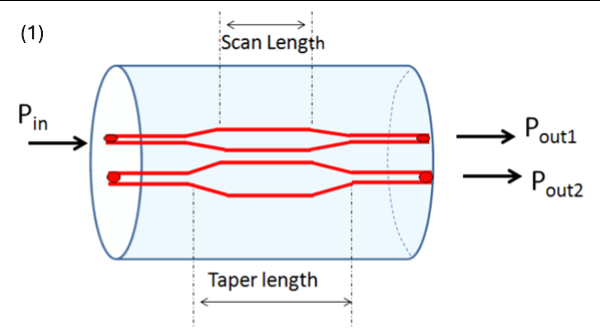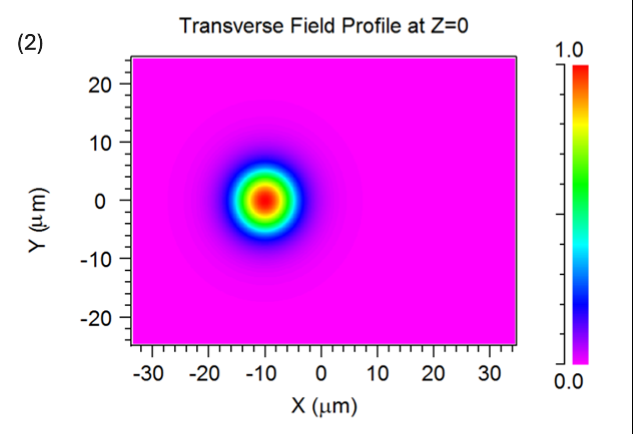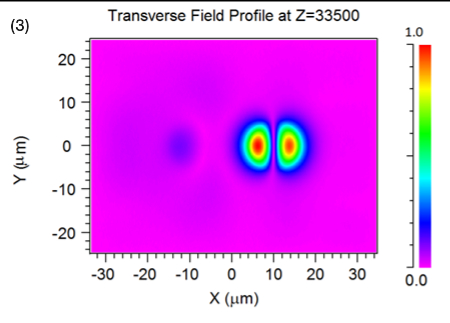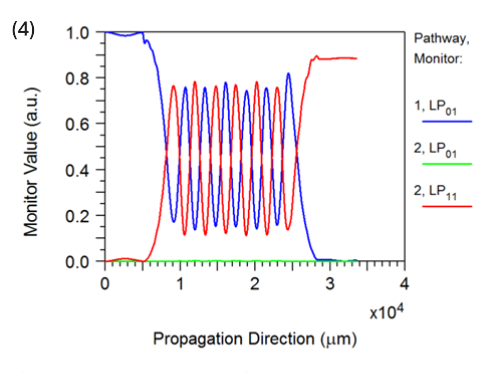This invention is a fiber-based mode converter utilizing a two-core fiber structure. The first core of the fiber is designed to support a single mode of Linearly Polarized (LP) modes and is used to receive input signals. The second core, referred to as a two-mode core, is configured to support multiple modes of LP modes. The patent describes a coupling between the single mode of the first core and one mode among the multiple modes of the second core, facilitating the conversion of modes within the fiber. This technology offers a method for efficiently converting modes within optical fibers, potentially enabling applications in telecommunications and optical signal processing.
Figure (1) Schematic representation of thermally expanded core (TEC) two-core fiber. (2) Input of the mode converter simulated using BeamProp. Input is given to the single-mode core, at -10 µm. (3) Output of the mode converter simulated using BeamProp. Input is given to the single-mode core at -10 µm. More than 90% power coupled to the two-mode core LP11 mode. (4) Measured power in each mode of the thermally expanded twin-core fiber along the propagation direction. No power coupled to LP01 mode of the two-mode core.
The primary problem addressed by this patent is the need for efficient and robust mode conversion in optical fibers for mode division multiplexing (MDM) applications. Existing solutions using bulk optics and other fiber-based converters are either bulky, highly sensitive to structural parameters, or affected by environmental fluctuations, making them unreliable and cost-ineffective for practical use.
- Efficient mode conversion: This innovation achieves high conversion efficiency and extinction ratio due to precise phase matching and thermal expansion. It is robust against small variations in structural parameters and environmental conditions.
- Broad wavelength range: It operates effectively across the entire C-band (1530 to 1565 nm), making it versatile for various optical communication applications.
- Compact and fiber-compatible: Unlike bulk optics-based converters, the fiber-based design is compact and compatible with existing fiber optic networks.
Technical Features:
- Two-core fiber design: A single-mode core (first core) supports a single mode of Linearly Polarized (LP) modes, specifically the fundamental mode (LP01). A two-mode core (second core) supports a plurality of LP modes, including the fundamental mode (LP01) and the next higher order mode (LP11).
- Mode conversion via thermal expansion: The single mode of the first core is coupled to one mode of the plurality of modes of the second core through thermal expansion, specifically coupling the LP01 mode of the single-mode core to the LP11 mode of the two-mode core.
- Thermally diffused core technique (TDCT): High-temperature heat treatment causes dopant diffusion in the cores, expanding them and facilitating strong coupling between the modes.
- Length: The total length of the two-core fiber is approximately 33-34 mm, with a heating (scan) length of 13-14 mm and a total taper length of 23-24 mm.
- Core diameters and refractive indices:
(i) Single-mode core diameter: 9.8 µm to 10 µm, refractive index: 1.4547.
(ii) Two-mode core diameter: 11.8 µm to 12 µm, refractive index: 1.4576.
- Separation: The cores are separated by 8.8 µm to 9.2 µm, with a center-to-center separation of 19.8 µm to 20.2 µm.
- Thermal expansion: Post heating, the single-mode core expands to 18.6 µm, and the two-mode core expands to 20.6 µm.
This product is quite useful in optical fiber communication. To the best of our knowledge, this product is not available in the market.
3
This innovation enhances the capacity and efficiency of optical communication networks, supporting the increasing demand for high-speed internet and data services. It provides a cost-effective solution for mode conversion, potentially reducing the overall costs of optical network infrastructure.
This technology facilitates advancements in telecommunications, data centers, and optical sensing, contributing to technological progress and innovation.
It has applications in Telecommunications (fiber-optic communication networks, internet service providers, broadband infrastructure), data centers, optical networking equipment, information technology, offering the following:
- Enhanced capacity and performance in optical networks via mode division multiplexing
- Applications in optical signal processing including filters and wavelength routing
- Efficient signal routing and processing in data centers and telecommunications
- Potential for robust and efficient mode conversion in future fiber optic systems
Geography of IP
Type of IP
201921009759
462192




